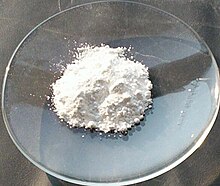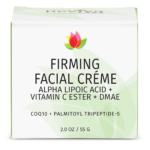Zinc Oxide
Zinc Oxide is powdered, oxidized zinc derived from the naturally occurring mineral, zincite, and routinely used in a wide range of consumer products. It is well recognized as a key sunscreen ingredient that is effective in providing protection from UV light. It plays an important role in safeguarding public health.
Zinc oxide is an inorganic compound with the formula ZnO. It is a white powder that is insoluble in water. ZnO is used as an additive in numerous materials and products including cosmetics, food supplements, rubbers, plastics, ceramics, glass, cement, lubricants, paints, ointments, adhesives, sealants, pigments, foods, batteries, ferrites, fire retardants, and first-aid tapes. Although it occurs naturally as the mineral zincite, most zinc oxide is produced synthetically.

| |
| Names | |
|---|---|
| Other names
Zinc white, calamine, philosopher's wool, Chinese white, flowers of zinc
| |
| Identifiers | |
3D model (JSmol)
|
|
| ChEBI | |
| ChEMBL | |
| ChemSpider | |
| DrugBank | |
| ECHA InfoCard | 100.013.839 |
| EC Number |
|
| 13738 | |
| KEGG | |
PubChem CID
|
|
| RTECS number |
|
| UNII | |
| UN number | 3077 |
CompTox Dashboard (EPA)
|
|
| |
| |
| Properties | |
| ZnO | |
| Molar mass | 81.406 g/mol |
| Appearance | White solid |
| Odor | Odorless |
| Density | 5.606 g/cm3 |
| Melting point | 1,974 °C (3,585 °F; 2,247 K) (decomposes) |
| Boiling point | 2,360 °C (4,280 °F; 2,630 K) (decomposes) |
| 0.0004% (17.8°C) | |
| Band gap | 3.3 eV (direct) |
| −27.2·10−6 cm3/mol | |
Refractive index (nD)
|
n1=2.013, n2=2.029 |
| Structure | |
| Wurtzite | |
| C6v4-P63mc | |
a = 3.2495 Å, c = 5.2069 Å
| |
Formula units (Z)
|
2 |
| Tetrahedral | |
| Thermochemistry | |
Heat capacity (C)
|
40.3 J·K−1mol−1 |
Std molar
entropy (S⦵298) |
43.7±0.4 J·K−1mol−1 |
Std enthalpy of
formation (ΔfH⦵298) |
-350.5±0.3 kJ mol−1 |
Gibbs free energy (ΔfG⦵)
|
-320.5 kJ mol−1 |
| Pharmacology | |
| QA07XA91 (WHO) | |
| Hazards | |
| GHS labelling: | |

| |
| Warning | |
| H400, H401 | |
| P273, P391, P501 | |
| NFPA 704 (fire diamond) | |
| Flash point | 1,436 °C (2,617 °F; 1,709 K) |
| Lethal dose or concentration (LD, LC): | |
LD50 (median dose)
|
240 mg/kg (intraperitoneal, rat) 7950 mg/kg (rat, oral) |
LC50 (median concentration)
|
2500 mg/m3 (mouse) |
LCLo (lowest published)
|
2500 mg/m3 (guinea pig, 3–4 h) |
| NIOSH (US health exposure limits): | |
PEL (Permissible)
|
TWA 5 mg/m3 (fume) TWA 15 mg/m3 (total dust) TWA 5 mg/m3 (resp dust) |
REL (Recommended)
|
Dust: TWA 5 mg/m3 C 15 mg/m3 Fume: TWA 5 mg/m3 ST 10 mg/m3 |
IDLH (Immediate danger)
|
500 mg/m3 |
| Safety data sheet (SDS) | ICSC 0208 |
| Related compounds | |
Other anions
|
Zinc sulfide Zinc selenide Zinc telluride |
Other cations
|
Cadmium oxide Mercury(II) oxide |
Except where otherwise noted, data are given for materials in their standard state (at 25 °C [77 °F], 100 kPa).
| |
ZnO is a wide-band gap semiconductor of the II-VI semiconductor group. The native doping of the semiconductor due to oxygen vacancies or zinc interstitials is n-type. Other favorable properties include good transparency, high electron mobility, wide band gap, and strong room-temperature luminescence. Those properties make ZnO valuable for a variety of emerging applications: transparent electrodes in liquid crystal displays, energy-saving or heat-protecting windows, and electronics as thin-film transistors and light-emitting diodes.










